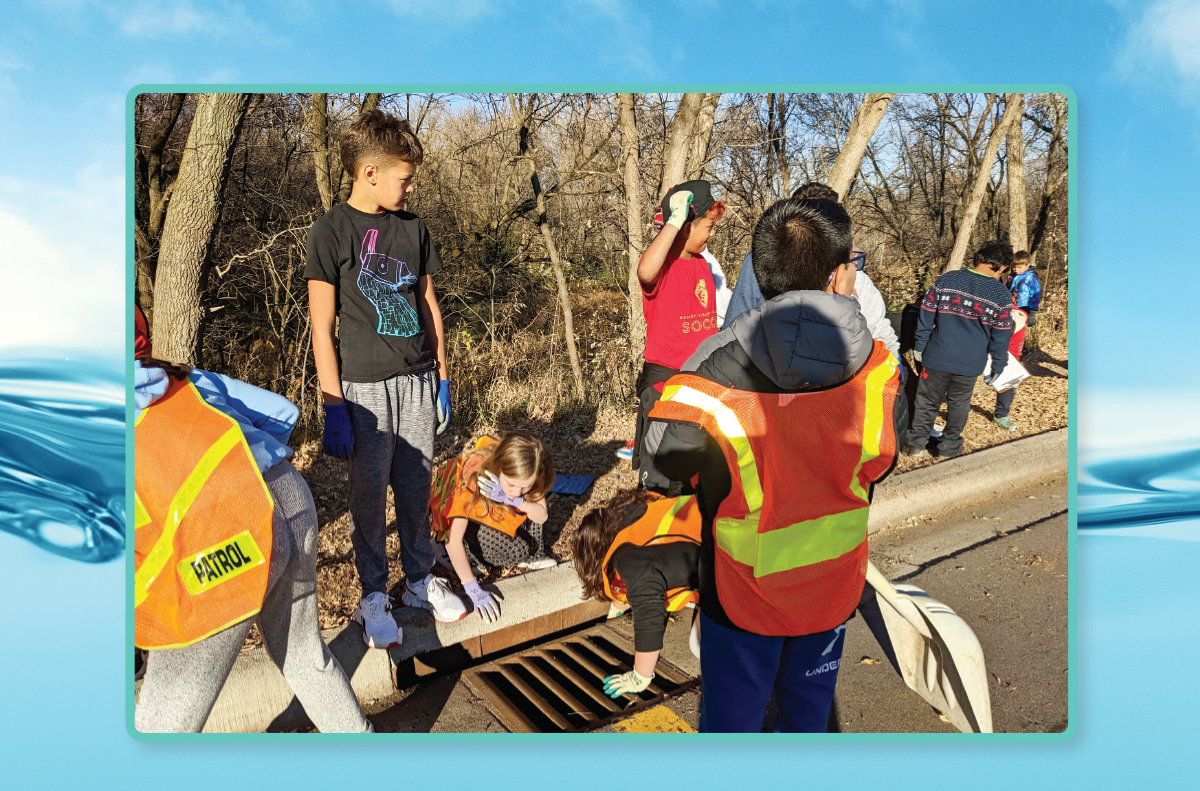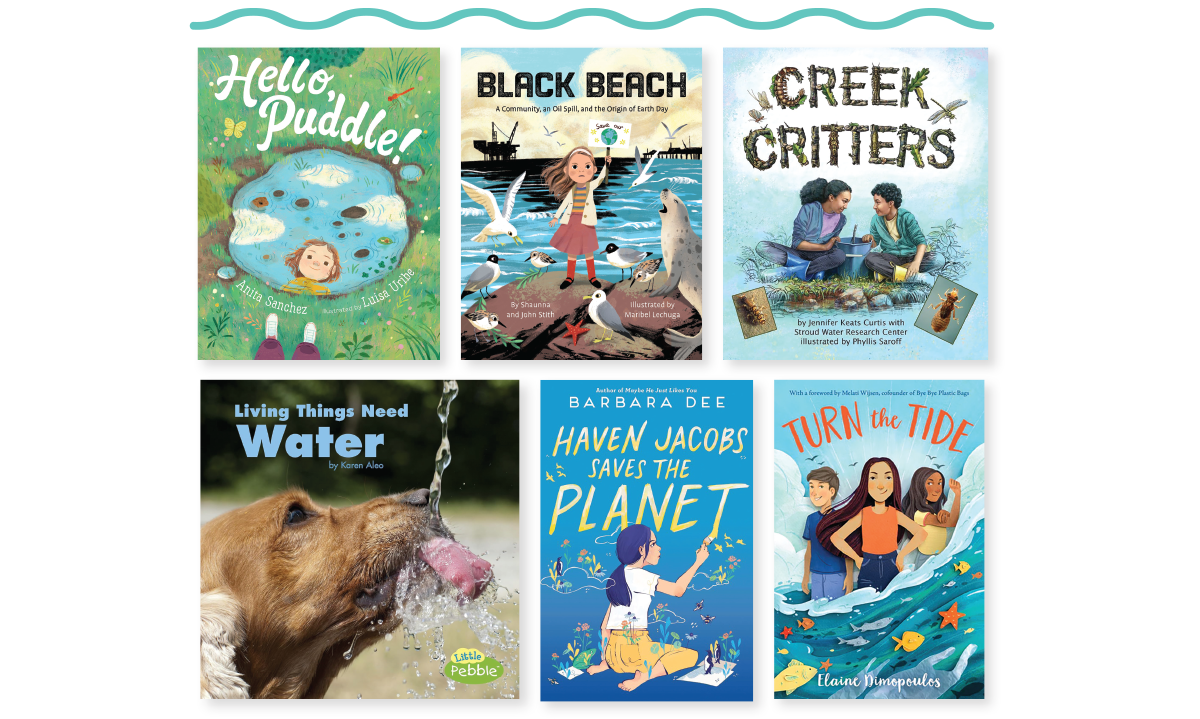Honoring H20: Resources to Teach About the Vital Importance of Clean Water
Activities, books, and online tools address issues including the impact of pet waste on water systems, measuring water footprints, and how activists raise awareness about conservation.
 |
Student volunteers help unclog storm drains.Courtesy of Kimberly Benton |
In the article |
No matter who you are or where you live, the start of your day probably includes water. August is National Water Quality Month, which was started in 2005 by the Environmental Protection Agency (EPA) and backed by the United Nations to get people thinking seriously about conservation of this vital natural resource and to prioritize safe drinking water for everyone. The internet is virtually overflowing with information and activities to teach students about water quality. Librarians can support both literacy and science by doing a deep dive into the topic.
A recent Harvard research study linked building student background knowledge in science to improvements in reading comprehension. Themed content is a key factor in helping students understand concepts from a variety of perspectives and apply their knowledge in and outside of the classroom.
There are many ways to approach creating lessons on the importance of clean water, and librarians are in a unique position to do so by making meaningful science connections to local contexts. Understanding how water quality impacts their immediate environment can motivate students’ inquiry and participation in community change.
Also read: Eco-Action: Turning Students’ Climate Anxiety into Agency
Minnesota school librarian Kim Benton, who is also an elementary science specialist, aims to do just that. Twice a year, Benton leads a group of fourth grade students in cleaning out storm drains in her area (pictured above), since organic waste and other runoff pollutants are a primary threat to water quality in the United States. Benton and the students map the drains on or adjacent to the school property and learn about the importance of keeping them clean. “And then...we clean them!” she says. They weigh the debris collected and report the results to Adopt-a-Drain.org, a national group that seeks volunteers to help unclog storm drains twice a month and keep track of the accumulated debris.
Water scarcity is another key topic that librarians can explore with students. Kids in the United States may well be aware of imperiled drinking water supplies in distant parts of the world, driven home by images such as those of livestock sharing water sources with people in African countries. But they should also know of threats to drinking water in states including Michigan or Arizona, as well as the impact of domestic pets on U.S. water quality.
Consider this statistic: the Washington State Department of Ecology notes that there are 1.6 million dogs in the state, which means hundreds of tons of dog waste every day. Dog waste contaminates coastal shellfish; causes algal bloom in rivers and lakes, impacting the health of aquatic animals; and makes its way into drinking water through storm drains and runoff into water sources. Kids can understand that the impact they can have in picking up after pets carries immediate and long-term relevance.
When deciding what water quality themes to focus on, consider these broad topics:
- the importance of clean water for individual health
- water as a system that connects environment and community
- recognizing the water quality needs of the environment
- water in nature as a living entity, including Indigenous ways of knowing
This booklist about U.S. water issues, with links to standards-aligned activities and curriculum guides, promotes partnering and extending learning into the community.

The importance of clean water for individual health
The Water Lady: How Darlene Arviso Helps a Thirsty Navajo Nation by Alice B. McGinty, illus. by Shonto Begay (Dineh’ [Navajo]). Random/Anne Schwartz. 2021.
Pre-S-Gr 3–Introduced through the lived experience of a young Navajo boy, this picture book presents the reality of water insecurity for people living on the Navajo Nation, where most families use only seven gallons of water a day. The role of Darlene Arviso is highlighted as she brings water to families and connects the community.
Poisoned Water: How the Citizens of Flint, Michigan, Fought for Their Lives and Warned the Nation by Candy J. Cooper and Marc Aronson. Bloomsbury. 2020.
Gr 7 Up–This accessible young reader’s version of the award-winning original reporting on the Flint Crisis includes an array of primary sources—including interviews, legal documents, charts, reports, and photographs—that bring the story to life in short, 10-page chapters. Undergirding the issue of water quality is the historic segregation and racism that the community still fights today.

A system connecting environment and community
City of Water (ThinkCities) by Andrea Curtis, illus. by Katy Dockrill. Groundwood. 2021.
Gr 3-7–Colorful illustrations and cartoon-like diagrams pull together the “story” of water as it is put to use in a community. Contains fascinating facts and suggestions for ways to conserve this important natural resource.
Water: Discovering the Precious Resource All Around Us (Spectacular STEAM for Curious Readers (SSCR)) by Olga Fadeeva. tr. by Lena Traer. Eerdmans. Apr. 2024.
Gr 4-6–Relevant water facts and history are integrated into densely packed snippets on full-page illustrations, making this a picture book for more experienced readers. Fifty-six pages of nonfiction narrative sweep readers along, while the space and font variety of text invite nonlinear reading that will spark varied interests.
Hidden Systems: Water, Electricity, the Internet, and the Secrets Behind the Systems We Use Every Day (A Graphic Novel) by Dan Nott. Random House. 2023.
Gr 7-9–This extraordinary graphic novel presents the water cycle from natural to regulated use over time. Communicated in accessible chunks of information, comic-style panels integrate environmental, social, and economic concepts essential to understanding water quality.

Water quality needs of the environment
Hello, Puddle! by Anita Sanchez, illus. by Luisa Uribe. Clarion. 2022.
PreS-Gr 3–An entire world lives in, on, and around a puddle of water in this vibrantly illustrated peek at the natural world.
Black Beach: A Community, an Oil Spill, and the Origin of Earth Day by Shaunna Stith & John Stith, illus. by Maribel Lechuga. little bee. 2023.
PreS-Gr 3–In this engaging picture book, an important part of environmental history is centered on the experience of a young activist who at first watches helplessly, then becomes involved in cleaning up an oil spill on a California beach. Media coverage of this true-life event sparks a reaction by people all over the country and continues to impact policy and action today.
Creek Critters by Jennifer Keats Curtis with Stroud Water Research Center, illus. by Phyllis Saroff. Arbordale. 2020.
PreS Up–With simple text, large print, and realistic illustrations, this nonfiction narrative models responsible ways of studying the health of a stream for young scientists. Back matter provides engaging worksheets, vocabulary lists, and links to downloads from the publisher’s website.
Living Things Need Water by Karen Aleo. Pebble. 2019.
PreS Up–High-quality photographs accompany brief text appropriate for visual learners that will spark student discourse about water use.
Haven Jacobs Saves the Planet by Barbara Dee. Aladdin. 2023.
Gr 4-8–This middle grade novel explores adolescent friendships and the topic of eco-anxiety. But it also illustrates the potential of place-based learning about environmental science, as the main characters learn how water quality affects the health of living macroinvertebrates.
Turn the Tide by Elaine Dimopoulos. Clarion. 2022.
Gr 4-8–Supportive family and community partnerships are highlighted in this middle grade novel, as a young activist works to rid her island home of plastic pollution and its harmful effects on a vulnerable ecosystem.

Water as a living entity, including Indigenous ways of knowing
We Are Water Protectors/Somos guardianes del agua by Carole Lindstrom (Anishinaabe/Métis), illus. by Michaela Goade (Tlingit). Roaring Brook. 2020.
PreS Up–The presence and priority of water as the giver of life is presented visually across pages and in the poetic text. People as stewards and protectors, rather than only consumers of water, are part of the flow of this powerful narrative.
I Know the River Loves Me/Yo sé que el río me ama by Maya Christina Gonzalez. Lee & Low. 2013.
K-Gr 3–This well-known book by the Chicana author/illustrator beautifully presents the river as a living entity, highlighting the idea of reciprocity with nature. Available as a bilingual Spanish/English edition.
Autumn Peltier, Water Warrior by Carole Lindstrom (Anishinaabe/Métis), illus. by Bridget George (Anishinaabe). Roaring Brook. 2023.
Gr 1-2–With a foreword by water activist Autumn Peltier, this Indigenous picture book biography shares the story of how one woman honored the gifts given by water and brought attention to clean water challenges by walking alongside the water with intertribal environmental advocates throughout North America.
Hello from Renn Lake by Michele Weber Hurwitz. Wendy Lamb. 2020.
Gr 3–7–As algal bloom threatens the health of a lake, the young protagonist and her friends take steps to solve the problem. Chapters alternate between the perspective of the young girl, Annalise, and Lake Renn, which can speak for itself. This well-crafted story is a great springboard for exploring the legal rights of nature presently being legislated in four U.S. states.
Related curricula and online resourcesThe Atlas of Common Freshwater Macroinvertebrates of Eastern North America Lesson Plans, Teacher Guides & Online Environmental Resources for Educators: Water | U.S. EPA Water Resources for Educators | Water Footprint Calculator Ocean Acidification Curriculum Collection | U.S. Climate Resilience Toolkit Project WET Water | Indigenous STEAM Action Guides & Lesson Plans | MonitorWater.org
How Clean Is That Water? | TeachEngineering.org Gr 6–A lesson about factors affecting water quality, and conditions needed for different animals and plants to survive. Monitoring Estuarine Water Quality: For Teachers | National Oceanic and Atmospheric Administration Water Quality Basics | PBS LearningMedia The Navajo Water Lady | CBS News |
Tiffany Coulson works as a public librarian and is a curriculum designer and grant writer for an educational nonprofit. Her professional interests include feminist research, mental health advocacy, family literacy, and culturally relevant approaches to curriculum design.
The job outlook in 2030: Librarians will be in demand
The job outlook in 2030: Librarians will be in demand
ALREADY A SUBSCRIBER? LOG IN
We are currently offering this content for free. Sign up now to activate your personal profile, where you can save articles for future viewing






Add Comment :-
Be the first reader to comment.
Comment Policy:
Comment should not be empty !!!